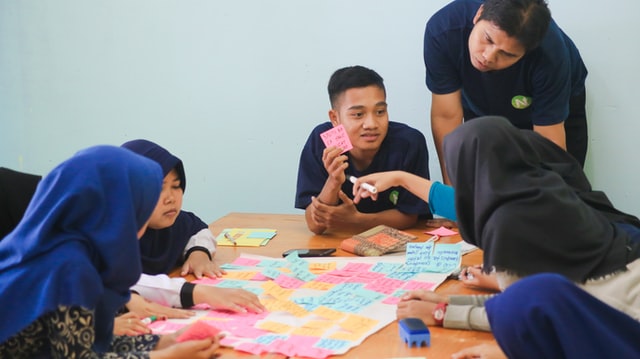Languages are ever-changing systems that are used for a practical purpose: communication. As time marches on, some words lose their meaning and get merged with other similar words in the brain. This process of words with similar meanings being merged together in the brain is called “colexification.”
While colexification is a natural process, and actually one of the ways for languages to streamline themselves. This loss of the distinction between words is actually one of the causes that can prevent students from learning class vocabulary properly as the new unfamiliar words are merged with more familiar concepts and the new words aren’t properly remembered.
After reading the research in this article, teachers will be much better armed to help their students with learning new words the way that their brain has developed to learn them most efficiently regardless of the age of the learner.
New Research on Learning Vocabulary

A recent study from the University of Edinburgh on the patterns and causes of colexification used an artificial language communication game to determine when and how the brain decides to merge or strengthen a newly learned word. The researchers found that while speakers naturally colexified similar words, there was one thing that could prevent this process.
The researchers reported that their data was “supporting the communicative need hypothesis: when faced with a frequent need to distinguish similar pairs of meanings, speakers adjust their colexification preferences to maintain communicative efficiency and avoid colexifying those similar meanings which need to be distinguished in communication.
This research provides further evidence to support the argument that languages are shaped by the needs and preferences of their speakers.” (Karjus et al.) This means that for words to be remembered, they need to be used in order to communicate, not just given in a list and memorized out of context.
Language has a purpose in the brain, and vocabulary aren’t generally stored in the brain in isolation. The brain is a series of connections that link ideas together. In order to learn new vocabulary in any useful sense, it has to be learned in a context that it can be connected to. When a word is necessary or used in a specific situation or to express a certain idea, it will be remembered more readily.
Helping Students Learn New Words Naturally in Class
While this research on learning new words seems logical as it goes with the old saying of “use it or lose it”, many teachers don’t utilize vocabulary in actual communicative activities. While teachers lecture using class terminology and have activities using it, they often don’t have natural conversations where students need to use class terminology in a purposeful context beyond filling in a blank.
Generally, new words are given in the form of a vocabulary list and students are expected to use rote memorization to commit each word to memory separately. This is especially true for elementary school where words are often given in weekly packets.
Some teachers may have students write sentences using the words, which is certainly a start at using words in context, but many students simply throw simple sentences together not really using the word for a purpose, but instead as a filler for a blank in their simple sentences. Other strategies will be more effective at actually getting students to engage with their vocabulary in a natural context.
Some may argue that teachers often ask questions where the answer will include one or more class terms during lectures, but these are usually not back and forth conversations with any but the most advanced and vocal students. Question-answer activities may be good for preparing students for tests where they need to fill in the blank, the shallow level of discussion will translate to a shallow level of understanding of the term itself. It is one thing to know a word, it is another thing entirely to know is subtleties and connotations.
Rather than just targeting one student in a question-answer style activity, teachers should seek to incorporate more activities where students speak to one another and need to utilize class vocabulary in order to achieve the goals of the activity. Not only will this allow all students to speak simultaneously, the back and forth conversations between students will help deepen their understanding of the term beyond just being the answer for a set question.
While teachers may worry that, without their guidance, students may struggle to understand and use the terms properly, this is actually a hidden benefit. With the wrong activity, even in groups, students may simply divide work and try to input answers with little to no discussion.
If students have to struggle with the words meaning and are unable to split work due to having to do the activity step by step, they will necessarily have to discuss the words they may or may not understand and perhaps even do some research into their notes or on the internet to seek further understanding of the term.
It will be significantly harder for students to learn to use vocabulary correctly without the teacher, but that is actually the whole point. The more students have to discuss, study, and figure out the difficult terms in a class, the deeper their understanding of those terms will be.
This can be made easier by having vocabulary introduced mindfully so that activities can use all of the words naturally. This will facilitate the creating of little games and scenarios where students can use their new words in context.
Especially in foreign language learning, having students doing little pair and talk activities where they use vocabulary to go through an active dialogue together will help them use words more naturally. Language teachers can group words by grammar and play little “Simon Says” type games where the use words to give commands and students have to respond appropriately with an action or verbal response. This will get the class up and moving, talking, and having fun rather than just writing a bunch of disconnected sentences.

The teacher should still circulate the classroom, giving guidance where needed, but guidance should be less about giving answers and more guidance on where to find the answers. This will allow the teacher to spot treat students who are off track while giving students significantly more time discussing and using the terms. As the teacher helps students progress along the step by step activity, they can also be watching for points of difficulty for multiple students and plan future activities and group discussion accordingly.
Rather than just giving students answers through lecturing, giving students the tools they need to learn and guiding them on how to use those tools will create more independent and long-term learners. Teachers often feel the need to pre-teach difficult terms and concepts, but actually allowing students to struggle through figuring out these concepts is part of the challenge of learning and, according to the latest neuroscience research, the best way to help them remember and understand new words and ideas and be able to use them in the future.
Want more like this? Make Lab to Class a part of your weekly professional development schedule by subscribing to updates below.
References
Karjus, Andres et al. “Conceptual Similarity And Communicative Need Shape Colexification: An Experimental Study”. Cognitive Science, vol 45, no. 9, 2021. Wiley, doi:10.1111/cogs.13035.



